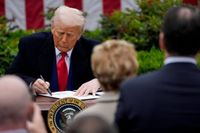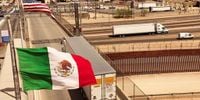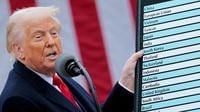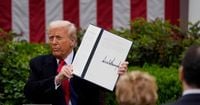On April 2, 2025, President Donald Trump announced a significant escalation in his trade policy, imposing reciprocal tariffs on approximately 60 countries while excluding Mexico and Canada from these new measures. This decision is part of a broader strategy to address what Trump describes as unfair trade practices that have harmed the U.S. economy.
The newly implemented tariffs, which will take effect on April 3, 2025, include a basic 10% tariff on imports from around the world, with higher rates for specific countries based on the tariffs they impose on U.S. goods. This means that nations like China will face a reciprocal tariff of 34%, while the European Union will see a 20% tariff. In contrast, Mexico and Canada will continue to enjoy a 0% tariff under the United States-Mexico-Canada Agreement (USMCA), also known as T-MEC.
Trump's administration justified these tariffs by citing the record U.S. trade deficit, which reached $1.2 trillion in 2024. The President stated, "For decades, our country has been looted, violated, and plundered by both friendly and unfriendly nations. But that will never happen again." He emphasized that his administration's goal is to rebalance international trade and protect American jobs.
Despite the exemption for Mexico and Canada, both countries still face significant tariffs on certain products. For instance, while goods that comply with T-MEC rules will remain tariff-free, those that do not will incur a 25% tariff. Additionally, energy products from Canada that do not meet the agreement's requirements will be subject to a 10% tariff. Moreover, starting April 3, Mexico will face a 25% tariff on automobiles manufactured outside the U.S., a significant concern given that Mexico is the largest importer of vehicles into the U.S.
Gabriela Siller, director of analysis at Banco Base, noted the relief that Mexico's exemption from the reciprocal tariffs brings. She stated, "What’s next for Mexico? Increase the percentage of exports sent to the U.S. under T-MEC, which reached 48% in 2024, and increase regional content." This sentiment reflects a broader understanding that the USMCA has provided a buffer against Trump's aggressive tariff policies.
Trump's announcement was made during a well-publicized event at the White House Rose Garden, where he framed the tariffs as a necessary step to reclaim America's economic independence. He declared, "This is a historic day where the United States proclaims its economic independence." However, he also warned that if any country retaliates with additional tariffs, the U.S. would respond with even stronger measures.
While the tariffs may provide short-term relief for U.S. industries, analysts caution that the long-term effects could be detrimental. Alfredo Coutiño, director for Latin America at Moody's Analytics, emphasized that the threat of tariffs still looms over Mexico due to its significant trade surplus with the U.S. He remarked, "It cannot be said that Mexico is free from tariff threats, as it remains a candidate for such measures. The uncertainty for the country has not dissipated but rather remains latent and waiting."
In the wake of Trump's announcement, the Mexican peso gained strength against the dollar, reflecting a degree of market relief following the news. However, analysts from BBVA noted that, aside from beer exports, Mexico's situation remains largely unchanged, as tariffs on automobiles, steel, and aluminum still persist. They argued that these tariffs violate the USMCA and could potentially be reversed in the near future.
The implications of these tariffs extend beyond immediate trade relations. Joan Domene, chief economist for Latin America at Oxford Economics, pointed out that the announcement positions Mexico as a more competitive player in the manufacturing sector, particularly in high-tech industries where it competes to be a primary supplier to the U.S.
Trump's rhetoric during the announcement echoed his campaign themes, reiterating that the U.S. has been "robbed" of jobs and that these tariffs are a defense of American workers. He stated, "If you want your tariffs to be zero, then manufacture your products here in the United States." This statement underscores his administration's ongoing push to incentivize domestic manufacturing and reduce reliance on foreign imports.
As the tariffs come into effect, the business community is left to grapple with the uncertainty surrounding U.S. trade policy. The White House has indicated that negotiations will continue, with Trump open to discussions with world leaders and industry stakeholders. The administration has received numerous calls from various sectors regarding the new tariffs, highlighting the contentious nature of this trade policy.
In summary, while Mexico and Canada have avoided the brunt of Trump's latest tariff measures, the broader implications of his trade policies continue to unfold. With significant tariffs still in place on various products, the potential for retaliatory measures remains a pressing concern. As the U.S. navigates this complex trade landscape, the outcomes will be closely watched by both domestic and international markets.









